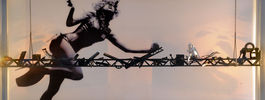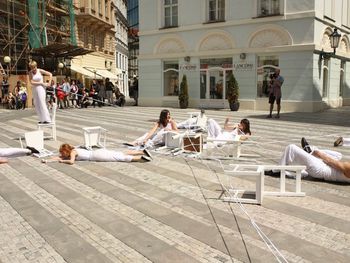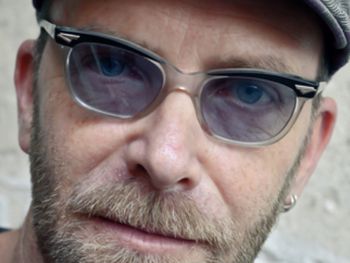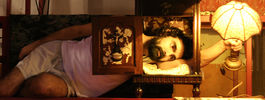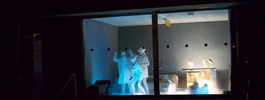This is the first time since the end of World War II that Polish stage designers are taking part in an international exhibition. During that period a great development took pláce on Polanďs opera and drama stages, as well as puppet theatres (some 110 of them)with stage design taking a most important place, both as far as quality and quantity are concerned. There are many artistic trends, a large number of stage designers (120 members of the section under the Union of Polish Artists) as well as many artistspainters collaborating with the theatre. In order to explain the scope of problems of stage design we have decided to include a greater numer of authors in our exhibit, whereby each of them is represented by one of his works only (limited amount). The documentation of each drama is so complete that it portrays the purpose of production and its staging. In explanation it must be noted that a scenographer in Poland creates the stage and costume design and is thus the author of the entire art element of a production. This is also the principle of the Polish School founded by Stanislaw Wyspianski, a painter and dramatist from the turn of the nineteenth and twentieth century, a principle which is carried forth by the work of the section under the Union of Polish Artists) as well as many artists- Wincenty Drabik, Andrzej Pronaszko, Wladystaw Daszewski and many others. Although the laws of tri-dimensional space and the functional arrangement of the stage were known by then, Polish stage design was influenced by the trends of modern art. This close link with art led to cubistic, surrealist decorations, to expressionism, primitivism even tashist technique was introduced in stage decor. Every trend opened a new view on classical drama (e. g. cubism discovered the monumental nature of romantic drama) or merged perfectly with contemporary drama (e. g. surrealism — Witkiewicz, Durrenmatt, Mrožek). At the same time, however, other trends made thein appearance which did not correspond to other branches of art, such as neo-realism which came into being around 1930 and still survives in view of the fact that stage designers use the structure of materiál for new technique (particularly the tashist technique) as well as for metaphoric and
surrealistic stage design. The neo-realistic foundations led to an endeavour
to bring theatrical convention and the drama closer together. It should
be noted that our scenography often makes use of folklore, nativity scenes,
painting on glass, cut-outs, an art which is eternally modern.
- Otto Axer
Additional information: x
Obrázky z katalogu
Exhibiting works
-
Williame Shakespeare: Macbeth (Macbeth ),
Teatr Polski
1964, Director: O. Azer,
- Zbigniew Bednarowicz
Additional information: Born in 1927. He studied at the Academy of Fine Arts in Poznan, where he graduated in 1951. He is now a painter and stage designer. Since 1951 he has been working for the Teatr Polski. in Poznan. He has received four prizes at annual theatre festivals held in Kalisz for his designs of productions of The Man in the Prompt-Box by T. Rittner, C.K. Norwid´ s The Ring of Noble Lady; J. Kasprowicz´ s Marcholt and E. Bryll´ s Regarding November. Among his other important stage designs the following should be mentioned: B. Brecht' s The Good Woman of Setzuan, 0. V. Horvath' s The Stranger from the Seine, Shakespeare' s Macbeth and J. Abramov' s Palace Derby. He has also designed several audio- visual / son et lumière/ performances, among others at the Town Hall and Citadel in Poznan.
Obrázky z katalogu
Exhibiting works
-
: (The Marcholt ),
Teatr Polski
1965
- Wladyslaw Daszewski
Additional information: Born in 1902. Painter and designer. In 1924 he graduated from the Academy of Fine Arts where he was appointed professor of scenografy. He was a collaborator of L. Schiller and is considered to be the founder and creator of Polish neorealism (1930). He stages mainly comedies. He was awarded the Grand Prix of the International Exhibition in Paris in 1937, the Prize of the Ministry of Arts and Culture, the First Prize of the Shakespeare Festival, the National Prize. He has done his best stage designs for the following plays: A. Nowaczynski's War to War (1927) (his first staging), W. Shakespeare's Measure for Measure (1933), A Midsummer Nighťs Dream (1936) and The Tempest (1947), Comeille's Cid (1936), Roja's Celestine (1947), Slowacki's Kordian (1956), S. Becketťs Waiting for Godot (1957), The Deliverance by S. Wyspiaňski (1957).
Obrázky z katalogu
- Urszula Gogulska
Additional information: Born in 1931. She finished her studies at the Academy of Fine Arts in Cracow, she is now the stage designer of the Theatre Ludowy in Nowa Huta. Among her best stagings are the designs of the plays: B. Brechťs Mother Courage, W. Shakespeare's Macbeth, J. Slowacki´s Balladyna and E. 0'Neill's Long Day's Journey into Night.
Obrázky z katalogu
Exhibiting works
-
: (Sunset),
Teatr Stary
1966
- Aleksander Jedrzejewski
Additional information: x
Obrázky z katalogu
- Jadwiga Przeradzka
Additional information: Born in 1902. She completed her studies at the Academy of Fine Arts in Warsaw. She works for the Polish Theatre in Wroclaw. She has been awarded the Prize of Ministry of Arts and Culture and the Artistic Prize of Wroclaw. Among her most important works are the costume designs for Othello and A Midsummer Nighťs Dream by Shakespeare, Brechťs Threepenny Opera and for Jonson's Volpone.
Obrázky z katalogu
- Tadeusz Kantor
Additional information: Tadeusz Kantor (1915-1990) began his „Theatre of the Reality of the Lowest Rank" with the production of The Return of Odysseus by Wyspiaňski (1944). With this revelation of the poor theatre, the artist would return with his own theatre CRICOT 2 - and beginning with The Dead Class (1975) to the latest production Iťs My Birthday Today (1990), he joined the greatest creators of the worlďs theatre.
Obrázky z katalogu
- Adam Killian
* 1923, Lwów
Specialization: set designer
Additional information: He finished his studies of architecture at the College of Arts and Crafts in Nottingham (Great Britain). At present he works as scenographer of the theatre Lalka in Warsaw. He has been awarded the National prize and the Prize for the stage design for the play The Nuptials by S. Wyspiaňski. His staging of the play Guignol in Troubles was awarded the Golden Medal at the International Festival of Puppet Theatres in Bucharest in 1960. His illustrations of children's books were awarded a Golden Medal at the Xllth Triennial in Milano. His most important works include the stage designs for the theatre of Szczecin and Warsaw and the staging The Cracowians and the Mountaineers. Until now he has designed 22 puppet films and illustrated 5o books.
He worked as an Apprentice at the Film Studio MOSFILM Alma-Ata. Over the course of 50 years, he has created almost 300 scenic designs for puppet, drama and lyric theatres.
He exhibited at PQ in 1971-79, 1987, 1995. In 1975 he received the Gold medal.
Obrázky z katalogu
Exhibiting works
-
: (Lodoiska),
Teatr Klasyczny
1962
- Jan Kosiński
Additional information: x
Obrázky z katalogu
Exhibiting works
-
: (Oedipus Rex ),
Opera
1962
- Łucja Kossakowska
Additional information: Born in 1928. She finished her studies at the Academy of Fine Arts and at the Department of Scenography in Warsaw. She works since 1955 for the National Theatre in Warsaw. Among her best works are the costumes for the following plays: Prince of Homburg by H. v. Kleist, M. Frisch´s Don Juan and the stage design for Szaniawski's The Bridge and R. Hochhuth's The Representative.
Obrázky z katalogu
Exhibiting works
-
: (The Representative ),
Teatr Narodowy
1966
- Wojciech Krakowski
Additional information: Born in 1927. Stage designer and art historian. In 1952 diplomaed at the College of Fine Arts in Cracow. Collaborates with numerous theatres. He acts as stage designer of the Stary Theatre in Cracow. His most important realizations are designs for Herr Puntila and his Servant Matti by B. Brecht, Tarelkine's Death by Suchovo- Kobyline, The Bedbug by Maiakowsky, Woyzeck by G. Büchner, Death of a Salesman by A. Miller, My Little Daughter by Róžewicz.
Obrázky z katalogu
Exhibiting works
-
: (Woyzeck),
Teatr Stary
1966
- Andrzej Majewski
* 1936, Warsaw
Specialization: director, set designer, costume designer, painter
Additional information: He is leading stage designer at the Teatr Wielki - National Opera in Warsaw. Dean of the Faculty of Stage design at Cracow's Academy of Fine Arts. He received the Gold Medal for stage design at the Triennial of stage and costume design in Novi Sad in 1966 and the Gold Medal for costume design at the PQ in 1967. He participated in PQ 1967, 1971 and in 1991.
Obrázky z katalogu
Exhibiting works
- Teresa Pietrusinska
- Jadwiga Poźakowska
Additional information: She was awarded a prize of the cultural monthly Litery of Gdaňsk for the ensemble of décors to Shakespeare.
Obrázky z katalogu
Exhibiting works
-
: (Whom the Bell Tolls ),
Teatr Wybrzeźe
1964
- Teresa Roszkowska
Additional information: x
Obrázky z katalogu
Exhibiting works
-
: (Electre),
Teatr Wojska Polskiego
1945
- Wojciech Síecíńskí
Additional information: x
Obrázky z katalogu
Exhibiting works
-
: (The Ninth Just),
Teatr Dramatyczny
1964
- Jerzy Skarźyński
Additional information: Mrs. and Mr. Skarzinski both studied at the Academy of Fine Arts in Cracow, at the Polytechnic and at the Film Institute. They made their debut at the Puppet Theatre in Cracow. At present they lecture at tne Academy of Fine Arta ín Cracow. Jerzy Skarzyński was born in 1924. Besides stage designing he also illustrates books and designs for films. He works mainly with the Groteska Theatre and tne Teatr Stary in Cracow as well as with theatres in foreign countries, for instance in Split, Hamburg, Amsterdam. His most significant works are the sets for Mrozek's Tango, Dürrenmatt's The Visit, Caligula by Camus, And
Quiet Flows the Bon by Sholokhov, School for Women by Liebermann, America by Kafka, The Treepenny Opera by Brecht, Cosi fan tutte by Mozart, Ulysses by Joyce and The Devils of Loudun by Penderecki.
Obrázky z katalogu
Exhibiting works
-
: (The School for Wives),
Opera
0
- Lydia Skarźyńska
Additional information: Scenographer, collaborating since 1948 with the puppet theatre Groteska in Cracow and since 1959 with the theatre Stary in Cracow.
Obrázky z katalogu
- Zenobiusz Strzelecki
Additional information: Born in 1915; stage designer, theoretician and historian in the field of stage design. Graduated from the Academy of Fine Arts and the Institute of Theatre Art in Warsaw. He has designed about 160 stage sets. He is the foremost of Dejmek's collaborators; he has created the stage sets for religious mystery plays. For his work he was awarded the Festival of Drama Prize in the Soviet Union and the Ministry of Art and Culture Prize. He is a professor at the Academy of Fine Arts in Warsaw. His best works include the scenes for Rej's Life of Joseph, Agamemnon by Aeschylus, Electra by Euripides, The Frogs by Aristophanes. He is the author of a two volume work Polska Plastyka Teatralna and a permanent contributor to the magazines Project, Teatr and Dialog.
Obrázky z katalogu
Exhibiting works
-
: (Agamemnon),
Teatr Narodowy
1964
- Józef Szajna
Additional information: x
Obrázky z katalogu
Exhibiting works
-
: (The Government Inspector),
Teatr Ludowy
1963
- Zofia Wierchowicz
Additional information: Completed studies at the College of Fine Arts in Warsaw in 1954. She has been collaborating with a number of theatres, and has designed stage sets to 100 drama performances, to twelve operas and ballets and costumes to 3 colour films. Her most important works are the scenic designs to War and Peace (Arnheim 1962), to Tannhäuser (Poznaň 1967), to the Pique Dáme (Poznaň 1967, Oslo 1969), to Tristan and Isolde (Poznaň 1969), to The Idiot (Warsaw 1968), to Crime and Punishnent (Poznaň 1969), to Romeo and Juliet (Warsaw Opera 1970), to The Lower Depths (Warsaw 1970) and to numerous plays by Shakespeare being presented at this exhibition. She has been awarded five times a prize at the Festival of Toruň and the First Prize for costume designs at the International Exhibition of Scenography in Novi Sad in 1969.
Obrázky z katalogu
Exhibiting works
-
: (Tannhäuser),
Opera
1967
- Kazimierz Wisniak
Additional information: Born in 1931; he graduated from the Academy of Fine Arts. He is one of the co-founders of the cabaret Piwnica in Cracow. He collaborates with various theatres in Warssw, with the J. Slowacki Theatre in Cracow, the H. Tomaszewski Pantomime at Wroclaw as well as with numerous theatres abroad, in Moscow, Kiev, Copenhagen, Helsinki, Oslo, Düsseldorf. His most significant works are the settings for Anouilh's Becket, Shakespeare's A Midsummer Night's Dream, Ostrovsky's Forest and Tchaikovsky's ballet Romeo and Juliet.
Obrázky z katalogu
- Ewa Starowieyska
Additional information: In 1956 diplomaed on stage and costume design at the College of Fine Arts in Warsaw. She is at work as stage designer of the theatre Teatr Wspólczesny in Warsaw vhere she has, among others, brought into effect sets for: The Résistible Ascension of Arturo Ui by B. Brecht, Tango by Mrožek, The Three Sisters by A. P. Chekhov; at the Teatr Polski: The Pedestrian in the Air by E. Ionesco; at the Ateneum Theatre: The Blacks by J. Genêt; at the Teatr Dramatyczny: Frank V, The Physicists, The Angel Descends Over Babylon; in Berlin: The Bedburg, in Düsseldorf: Tango, The Three Sisters, Androcles and the Lion; in Wuppertal: The Maids by Genêt, Woyzeck by Büchner, the ballets by Mozart and Hindemith; in Leningrad: Two Theatres by Szaniawski and The Resistible Ascension of Arturo Ui. E. Starowieyska is also an author of scenic designs for the television and the film.
Exhibiting works
-
: (Tango),
Teatr Wspóczesny
1965
- Andrzej Cybulski
Additional information: x
Exhibiting works
-
: (Cleopatra),
Teatr Narodowy
1967
- Andrzej Sadowski
Additional information: Born 1925 in Lwów. He works as a stage designer with number of drama theatres, the
Poznaň opera and the Chamber Opera in Warsaw. He lecturers at the Academy of Fine Arts
in Warsaw. He exhibited in the Prague Quadrennial 1967,1971 and 1975.
Exhibiting works
-
: (A Man For All ),
Teatr Narodowy
1965
- Marian Stańczak


